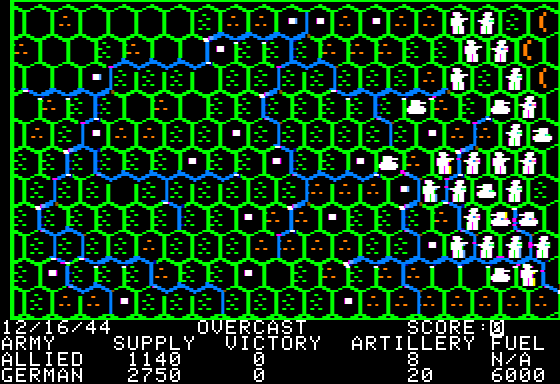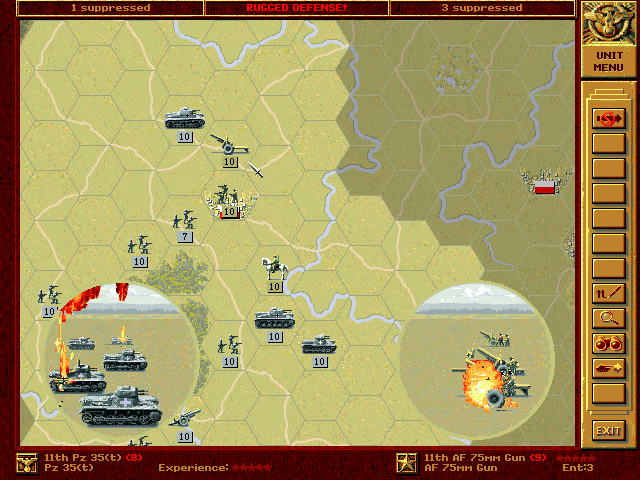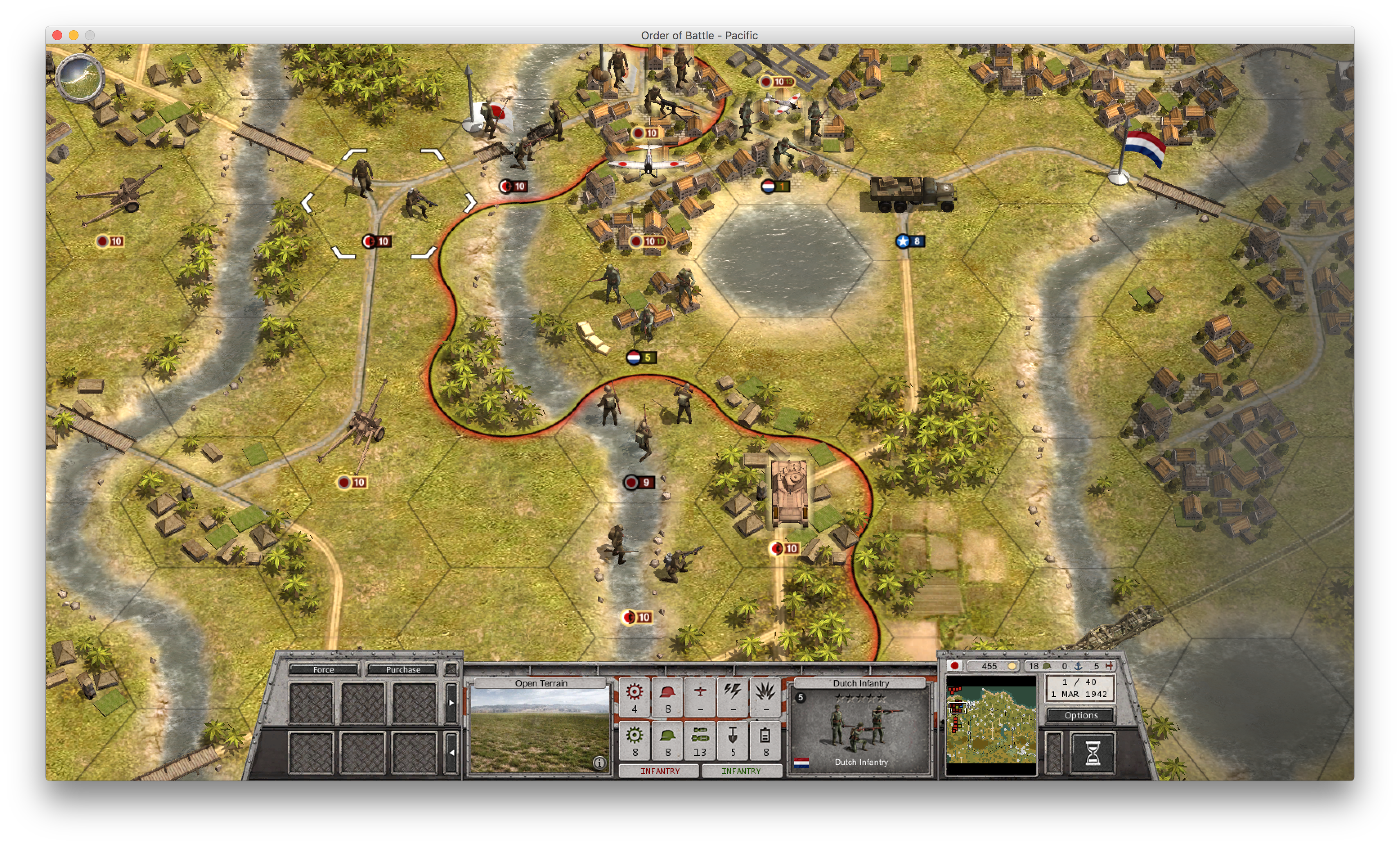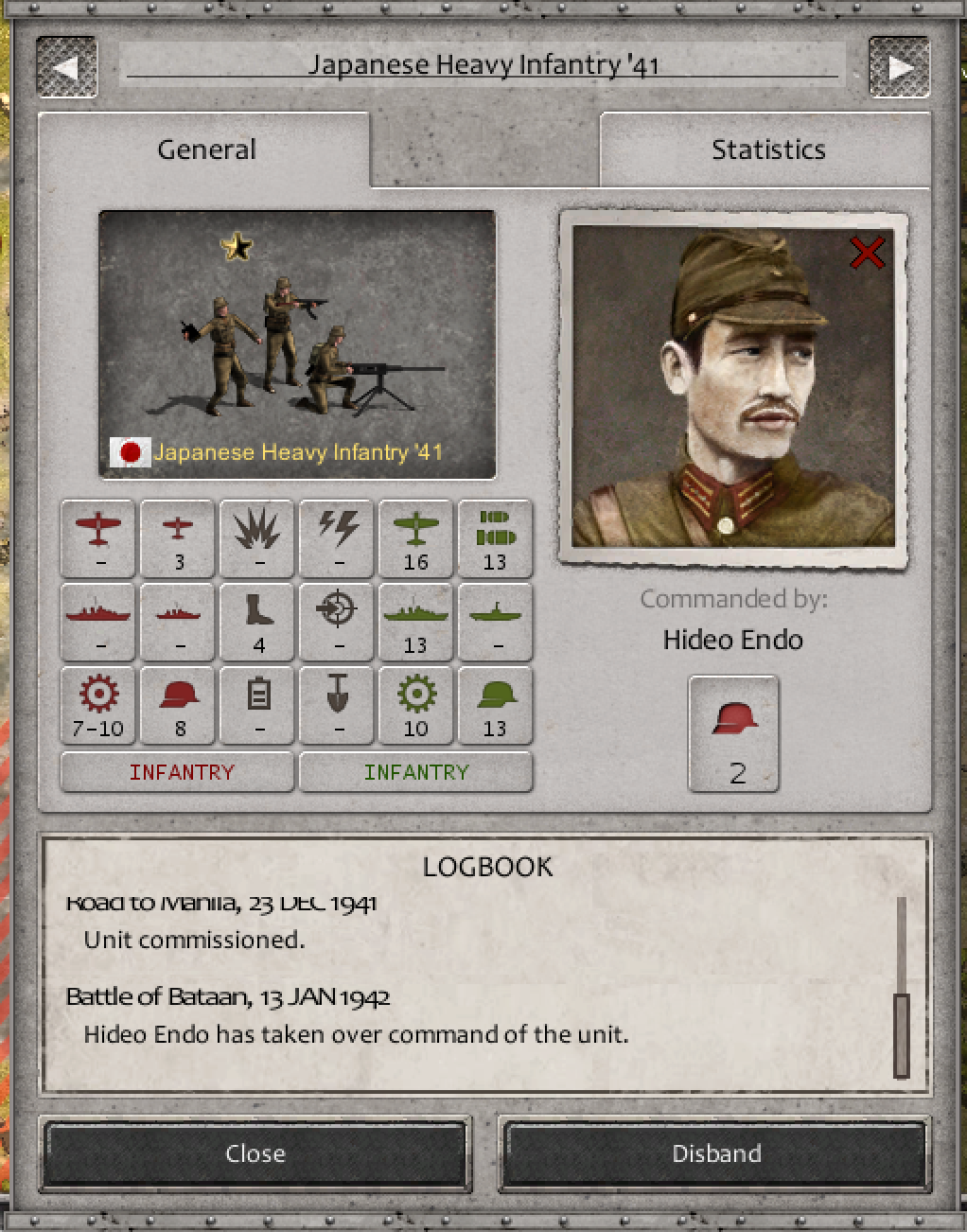This Is What We Talk About When We Talk About Hexagons
Dec 23, 2015 · peterb · 9 minute readGames
Let’s talk about Order of Battle: Pacific. Let’s do it by talking about Panzer General. And let’s talk about Panzer General by talking about the history of computer wargames. In order to do that, let’s talk about the board-based wargames from the 1960s and 1970s. We could, of course, go even further back, but this is going to be long enough as it is.
In the 1960s and 1970s, board-based wargames gained some small measure of popularity, spearheaded by two companies, Avalon-Hill and, later, Simulations Publications Inc., or SPI. While both companies made games in different genres and with a variety of game mechanics, their bread-and-butter games were rules-heavy games played on hexagonally-tiled boards, and with combat mechanics that had a number of common features.
The best exemplar of the style is probably SPI’s “introductory” game Napoleon At Waterloo, which is freely available as a print and play game.
What were their games known for? Many (if not most) of their games featured a large number of units, often representing multiple soldiers, who exert zones of control (which means that pieces that come near each other interfere with each other’s movement), and combat results tables that are consulted when battle occurs. Below is the combat results table from my somewhat wrinkled paper copy of Napoleon At Waterloo. To resolve a combat, you add up the combat values of all the pieces on your side and the enemy’s and figure out the ratio of forces - 1 to 1, 2 to 1, 4 to 1 - which tells you what column to use. Then you roll a die, and that tells you what row to use. “Dr” is “Defender Retreats,” “Ar” is “Attacker Retreats,” “De” is “Defender eliminated,” and so on.

I’d like to call your attention to the middle column, labeled “1-1”. On a 1, 2, or 3 roll of the die, the defender retreats. On a 4, 5, and 6 roll, the attacker retreats. In other words, attacking with even forces is a coin flip.
People come up with all sorts of explanations for why these games used hexagons; the most commonly trotted out canard is about how it’s easier to tile a plane. But to me, the obvious truth is right there in the combat results table - the need for hexagons in these games are a direct consequence of a desire to allow the players to concentrate their forces and achieve a larger balance of forces in a single combat. If you don’t do that, as a player, then not only can you not win, but you can’t even make progress - in the common case, the game will just grind on aimlessly, flipping one coin after another.
These mechanics were all chosen for practical reasons. Any game is a set of abstractions, and those abstractions are chosen - usually - to strike a balance that makes the game playable, interesting, and fun. Surely, once wargames made the leap to computers, we’d strike a new balance, and not be tied down to all the same old abstractions that made sense when figuring things out with pen and paper?

Nope.
Most of the computer wargames of the early PC era share the mechanics, and thus the attributes, of their pen and paper forebears. Combat is static, mobility is limited, stalemates are common, games are long, and the density of (unimportant!) information is too high.
There were wargames that weren’t just nearly straight ports of the same old “combat ratio and a die roll” games from the 1970s, but a supermajority (like SSI’s Tigers In The Snow, pictured above), were, at heart, direct translations. But, perhaps I’m being unreasonably snarky here. We shouldn’t be surprised that many wargames were similar. Some people like what’s familiar, and so some transition period is expected. In the case of of computer wargames, that transition period lasted about 14 years. So this is why we have hexagons today, even though we don’t need them: social signalling. “This is the type of game you’d like. It has hexagons!”
In 1994, in a bid to save the then-failing genre, SSI’s “Special Projects Group” released Panzer General. This game was a revelation. It had a stunning revolutionary UI (for a wargame), “point and click to move and attack”. This may sound obvious to us now, but take it from those of us used to pressing the ‘5’ key to move a unit one hex to the southwest, this was an actual innovation. Beyond the surface, the game also tried to be clever about what information it showed you, and what information it hid - while undoubtedly there is some randomness in play here, at no time does the computer actually display a 6-sided die to you, which is an annoying habit that many games even today engage in (yes, Blood Bowl, I’m looking at you.) For those of you who have read my article on Advance Wars, it’s fair to say that Advance Wars is a slightly simplified version of Panzer General (even down to the combat animations).

In other words, Panzer General took a hard look at the conventions of the genre, discarded many of them, and ended up with a game that was better in many ways. Panzer General scenarios often involved mobility, multiple points of attack, encirclement, entrenchment, combined arms, and a core force of units that gained experience and travelled with you from scenario to scenario. There are places where I feel they were too conservative - to pick the most obvious example, Advance Wars demonstrates definitively that hex maps are completely unnecessary in a wargame - but let’s give them their due. Panzer General was bottled lightning. And many designers have spent a lot of effort trying to remake it.
Slitherine, in particular, has made a cottage industry of attempting, with much success, to rebottle the lightning. Off the top of my head, there’s Panzer Corps (“Panzer General but we changed the name”), Battle Academy (“Panzer General but with even more UI polish”), Warhammer 40k: Armageddon (“Panzer General in the grim future”), and now Order of Battle: Pacific.
I like Order of Battle: Pacific. I like it a lot. It draws clear inspiration from Pacific General while not being a strict clone. There are several aspects of the game that make it more interesting to me than the other games in its class.
Most importantly, the scenario design is very, very clever. Scenarios have primary and secondary goals, and to try to achieve them all will require some deft manuevering on your part. Should you achieve the secondary goals in a campaign game, then this reverberates throughout the playthrough (for example, if as the Japanese, you sink 3 battleships at Pearl Harbor, then American naval forces are weaker for the next few scenarios; destroy Clarke Airfield on the Philippines and American fighter cover weakens substantially. These sorts of changes make the secondary goals much more important, and much more interesting than the Panzer General-style “OK, here are some more resource points to buy units with” rewards.
The game does a good job of mixing up scenarios involving purely naval units, purely land units, and both. Naval combat and air combat are, as one would expect, very intertwined, and a mixture of forces is typically required to succeed. The game is attractive and engaging, works well at various view scales (which is unusual for games of this sort), and from a UI perspective is quite intuitive. As you progress through the campaigns (there’s both a Japanese and an Allied campaign), you’ll also accrue commanders who provide bonuses to units near them.

Another positive point is that the game models both unit supply and effectiveness in interesting and easy to understand ways. Unit supply is similar to what we’ve seen before in Unity of Command, where a unit has to be able to trace a clear path back to a supply depot or it begins to degrade in supply level. As you’d expect, units that are out of supply are much more liable to be degraded or destroyed. In addition, supply doesn’t just come from depots and cities - there are supply ships that can deliver supply to shores near your units, which is essential in a game where many of the scenarios require amphibious landings. Capturing enemy supply depots will make them yours, but only after a delay of several turns.
In addition to health, units also have an “efficiency” value. Units can lose efficiency by fighting, being under artillery or naval fire, or by traversing difficult terrain. A unit with poor efficiency will have a harder time dealing damage. Efficiency is recovered over time through rest. When this mechanic was first mentioned I was sure it was going to be irritating busywork, but I acutally find it quite engaging - it gives you a reason to rotate troops in and out of the front lines beyond “They’re about to be destroyed.”
There is a multiplayer mode that uses Slitherine’s online matchmaking system (this will be familiar to anyone who has played Field of Glory). There’s also a map editor that lets you “paint” your own maps; a number of custom scenarios - and even a few custom campaigns - are available on Slitherine’s web forums.
Are there things I would change? Of course! Like many games in this class, it it hurt by its own compulsive need to display all of the underlying statistics behind every unit on an information panel. They made some moves in the right direction - range of artillery, for example, is shown organically on the map rather than on the info pane - but the game can’t quite bring itself to break away from “Useless salad of meaningless numbers” in too many places.

Although the map UI is scalable, text is not, so if you have a large monitor you’ll be cranking down the resolution way below where you want so that you are able to read the text in the game.
The Mac version specifically has a few annoyances, the most egregious of which is that if playing full screen, you can’t app switch out. It’s 2015 - being able to cmd-tab to another window should be standard on all models. And intead of putting my save games and scenario metadata in either my Documents folder or in Application Support, Order of Battle: Pacific created a folder in my home directory (!), which is sort of like walking into someone’s house and putting your mud-caked feet on their kitchen table. I do hope they fix this in a future update.
But, honestly, these are all minor annoyances at most. Order of Battle: Pacific is one of the most enjoyable games of its sort - enough like Panzer General that it scratches the same itch, but bringing enough of its own to the table to be fun and interesting on its own terms.
Order of Battle: Pacific, Mac and Windows (iPad and Android versions announced) is $39.99 on Slitherine’s web site and as of this writing is currently on sale at Steam for just under $35.
Disclosure statement: Matrix Games and Slitherine graciously provided Tea Leaves with a review copy of Order of Battle: Pacific.